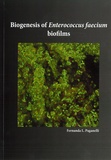Biogenesis of Enterococcus faecium biofilms
Summary
Nosocomial infections caused by Enterococcus faecium have rapidly increased worldwide and treatment options become more limited. The presence of antibiotic resistance genes and virulence factors in pathogenic E. faecium contribute to difficult-to-treat infections, frequently biofilm mediated, such as artificial-medical-device-associated infections. Biofilm is defined as a population of bacteria, encased in an extracellular matrix, attached to biotic surfaces, such as plants, animals and the human body, and abiotic surfaces, such as minerals. In ecosystems, nutrient availability is limited and, under these conditions, biofilm formation is an important adaptation for survival of microorganisms. Several processes have been described to be involved in specific steps of biofilm formation in different bacterial species; however, insights into E. faecium biofilm formation are limited. Therefore, the aim of the research described in this thesis was to identify new mechanisms involved in biofilm formation in E. faecium and new potential therapeutic options to treat biofilm infections. Using molecular tools, we elucidated five new mechanisms involved in biofilm formation in E. faecium and a list of potential biofilm associated genes, which increased our insights in the biofilm formation process in E. faecium pathogenesis.
